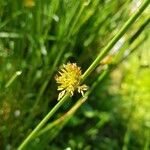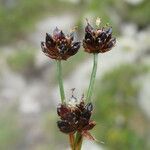Herbs, perennial, 2--10 dm. Rhizomes long-creeping. Culms erect, 1--3 mm diam. Cataphylls several. Leaves: blade usually absent (present in var. mexicanus). Inflorescences lateral, 3--many-flowered, loose to congested; primary bract barely exceeding to many times longer than inflorescence. Flowers variously pedicellate; bracteoles membranous; tepals chestnut brown or paler, lanceolate, (2.5--)3.3--5.5(--6) mm, margins clear; inner series loosely subtending capsule at maturity; usually slightly shorter, margins scarious to clear, apex acutish to obtuse; stamens 6, filaments 0.2--1.1 mm, anthers 0.9--2.2 mm; style 0.9--1.5 mm. Capsules 3-locular or infrequently pseudo-3-locular, oblate to narrowly ovoid, 3.5--4(--4.5) mm, equal to or exceeding perianth. Seeds dark amber, oblate to ellipsoid, 0.6--0.8 mm.


